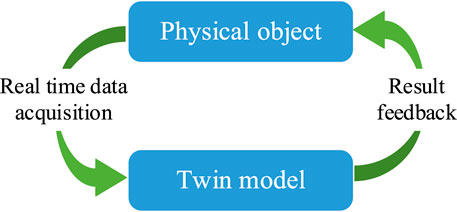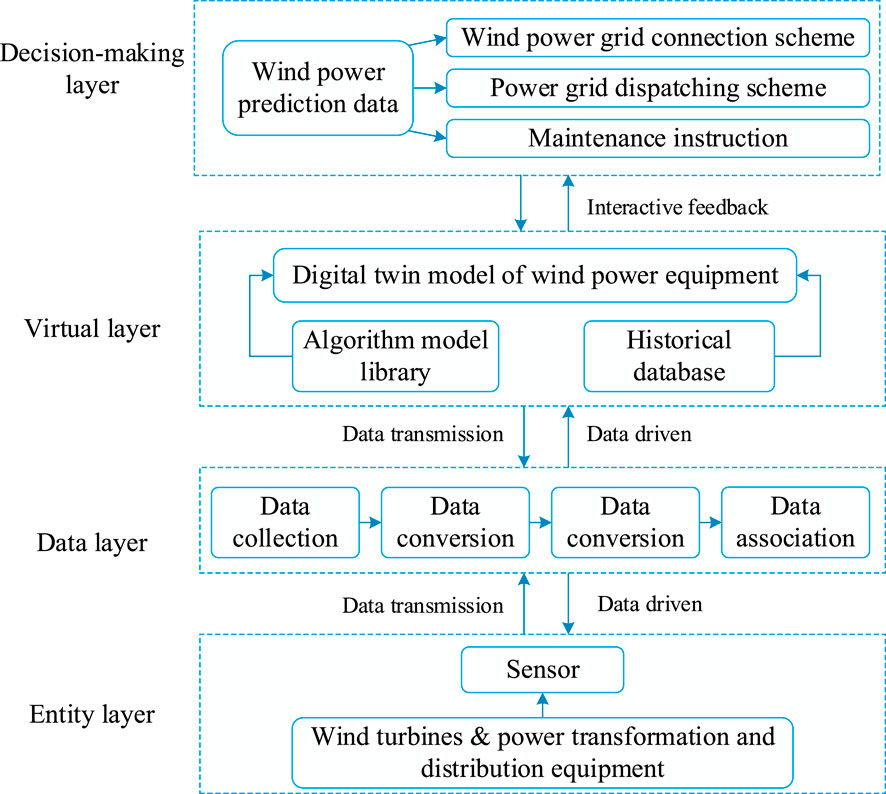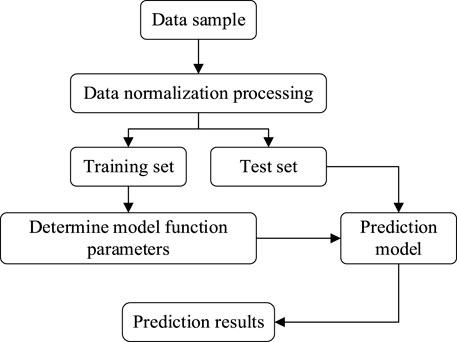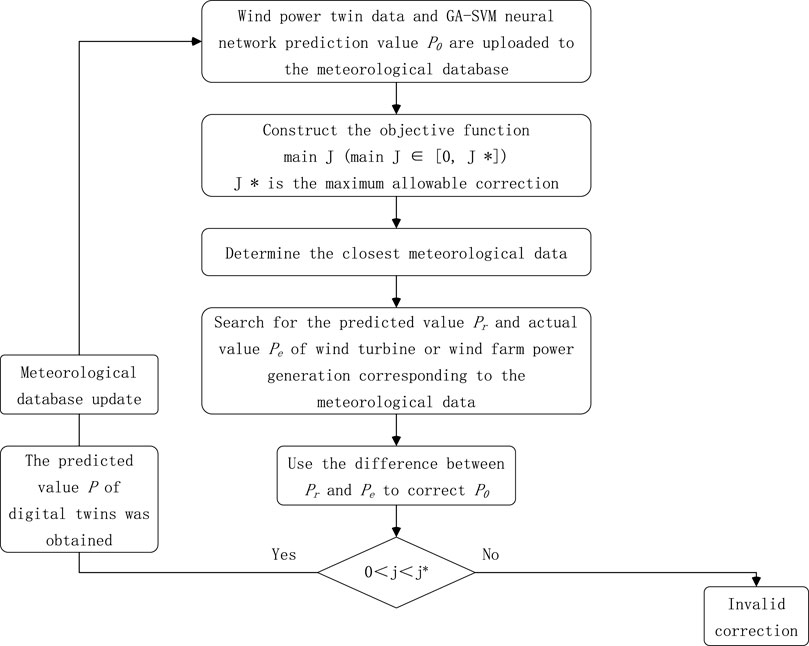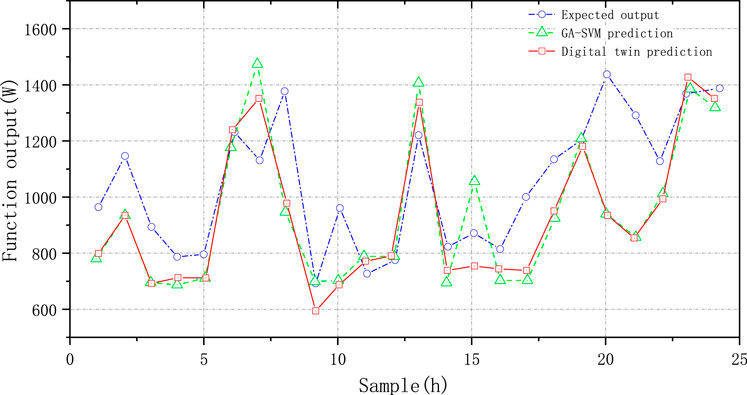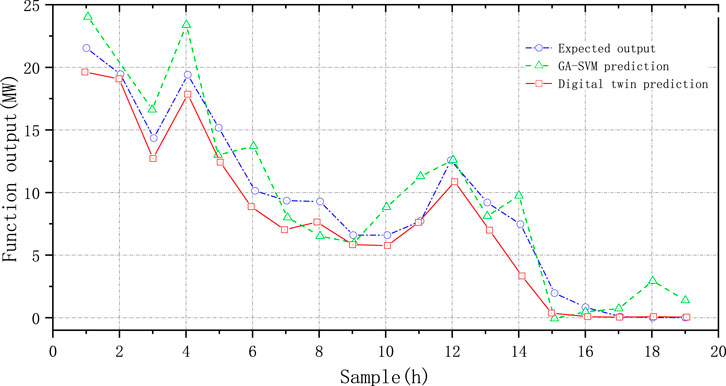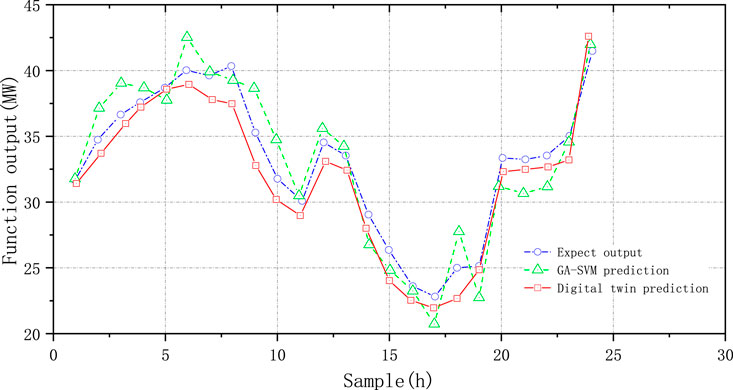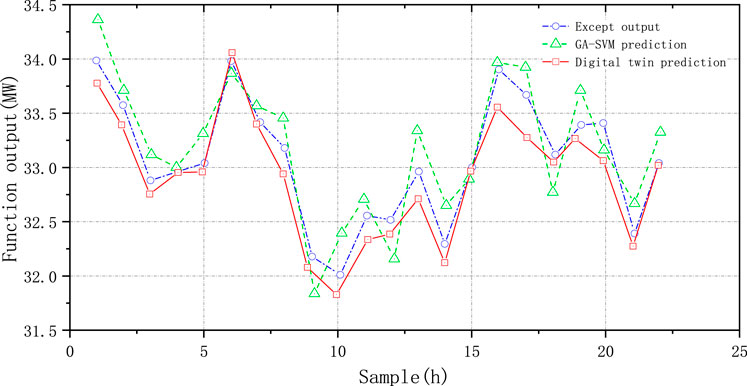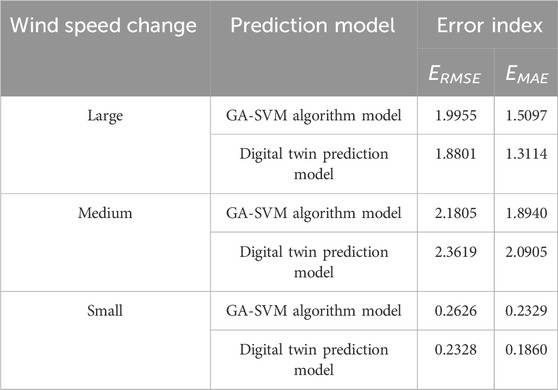- Shenyang Institute of Engineering, Shenyang, Liaoning, China
Wind power generation has become an indispensable part of the power supply side of the power grid. Due to the intermittent and uncertain characteristics of wind energy, short-term wind power prediction plays an important role in the stable operation of power system. By constructing the digital twin model, real-time and high-precision prediction of wind energy is realized. First, the genetic algorithm-support vector machine (GA-SVM) algorithm is used to build the model. Multidimensional sensors and meteorological stations of the virtual wind power generation system collected the meteorological data of the environment and updated the meteorological history database at the same time. Second, based on the collected meteorological data, the preliminary prediction results are obtained, and by searching in the historical database, the predicted value and the actual output value of wind turbines or wind farms under similar conditions are obtained. Finally, the prediction results of the GA-SVM are modified to obtain the predicted value of the digital twin model. The prediction method can greatly improve the accuracy of the short-term forecast of wind energy.
Introduction
Wind power generation is the main form of wind energy utilization. However, because wind energy is affected by the natural environment, it shows the characteristics of intermittency, randomness, and fluctuation of wind power, which have a great impact on the power grid. Prediction of wind power in wind farms can not only reduce the uncertainty of wind power generation and provide a basis for power grid operation and dispatching but also formulate maintenance plans for wind farms so as to reduce unnecessary risks and reduce the cost of wind power generation, while improving the utilization rate of wind energy. There are three types of forecasting methods (Peng, X et al., 2019; Yan, J.2014; Ding, T et al., 2017; Tian, Z et al., 2015; Tascikaraoglu, A et al., 2014).
He, Y., et al. (2017) combined the wavelet neural network, support vector machine, and time-series algorithm to predict the wind power in ultra-short term; the experimental results show that the combined prediction model can greatly improve the prediction accuracy of output power. Yin, H., et al. (2021) used the LSTM neural network with short-term and long-term memory ability of time-series data, which is effective when combined with the random search method to optimize the hyperparameters of the prediction model. Luo, F., et al. (2021) carried out the pretreatment of nonlinear time-series data based on the LSTM network using singular spectrum analysis (SAA). Yao, T. (2019) used the sparse autoencoder (SAE) network with a simple structure, less training difficulty, and stronger feature extraction ability to extract and predict the features of wind power. Liang et al. proposed a prediction method for intelligent identification and fluctuation rule mining of the fluctuation process of the total output of multiple wind farms, so as to obtain the trend of wind power 4h in the future.
At present, the difficulty of wind power forecasting lies in the forecasting accuracy and forecasting timeliness. The traditional forecasting method takes the average meteorological data as the input, so the forecast result is also the average power output. However, with the improvement in the dispatching accuracy, the average power output cannot meet the requirements. The real-time change in meteorological data will also cause the collected meteorological data to be updated in time, which will reduce the prediction accuracy.
The real operation data of Inner Mongolia and local wind tower data are used as research samples. First, the digital twin model is established by use of the improved neural network genetic algorithm-support vector machine (GA-SVM) model algorithm, and the initial power prediction is carried out. According to the approximate meteorological statistical parameters, the actual power value of the whole wind farm under the approximate historical conditions is obtained. Finally, the historical data in the wind farm database are used to revise the preliminary forecast results and get the final forecast results, namely, the digital twin-predicted value.
Digital twin technology and its application
In 2010, NASA proposed the concept of digital twins for the first time in the space technology roadmap. Integrated multiscale, probabilistic whole process simulation, with real-time synchronization, always mapping characteristics, can realize the interaction between the physical world and the digital scene, by integration of technical means. With the continuous progress of Big Data and scientific and technological means, digital twin technology can accurately integrate physical entities with information models. According to the high-speed transmission of sensor data, the real-time state can be changed so that the physical entity can be effectively simulated, monitored, predicted, and controlled (Chen, S et al., 2020; Liu, Y et al., 2021; Liu, S et al., 2022).
Digital twinning mainly includes three main parts: the physical object of real space, the twinning model of virtual space, and the information of closed-loop interaction between them, as shown in Figure 1. Real-time closed-loop information exchange is the key and difficult point in digital twin application.
The concept of digital twin has promoted the rapid development of smart wind farms and has been increasingly applied in the wind energy industry. With the support of Big Data, design, construction, and operations personnel will be able to use the digital twin to compare the idealized, engineered conditions of the equipment with the actual conditions of the actual project. In this way, we can constantly adjust and optimize the way we design, build, and operate. Digital twin technology will control the whole process of wind farm management cooperation.
Digital twin model of the wind power prediction system
Digital twin structure
The digital twin structure for wind power prediction is shown in Figure 2, which mainly includes four parts: entity layer, data layer, virtual layer, and decision-making layer.
Entity layer
The physical layer is the basis of the digital twin prediction system. It includes the wind turbine and wind farm transformer and distribution equipment and is the source of information and energy of the prediction system and also the real carrier of digital twin data. By collecting real-time data from sensors, the mapping relationship between physical devices and digital twins is constructed, and data for effective running and working environment are provided for the data layer (Wang, Y et al., 2021).
Data layer
The data layer should not only realize full coverage but also have certain self-management and analysis abilities to preprocess the data to ensure the rationality of the data so as to form a real-time and accurate perception system for ensuring the normal operation of the digital twin system (Morello, R et al., 2017). The data layer is a two-way transmission channel, which has the characteristics of high efficiency, security, flexibility, and reliability.
Virtual layer
The virtual layer is the core of digital twin prediction and the key to predict the power output. The virtual layer takes the collected data as the input of the algorithm model and trains it to improve the prediction accuracy of digital twins. In addition, through the search of the historical database, the actual output value and predicted value of the instantaneous wind turbine or wind farm under similar conditions are obtained, and then the results are corrected to obtain the final results.
Decision-making layer
The decision-making layer can make the grid connection safer and more stable. According to the obtained wind power prediction data, it generates the wind power grid connection scheme and guides the dispatching of the power grid (Fang, F et al., 2020). At the same time, it can also issue corresponding maintenance instructions in combination with the actual operation of the wind turbine so that the wind power system can work normally (Sun, R et al., 2021).
Working principle
The SVM algorithm is used to predict wind power and to train and model the historical data of active power and its corresponding variable data and the test data are used to test the prediction model. First, the sensor is used to collect the real-time meteorological data of the wind turbine environment. After normalization, it is tested as the input of the power prediction model, and the preliminary results are obtained. The SVM algorithm has good generalization ability and can well-solve the types of problems in non-linear pattern recognition. On this basis, the characteristics of the GA algorithm are used to optimize the parameter finding problem of the SVM.
On this basis, the digital twin is used as the skeleton of the power prediction model to connect wind farm, twin data, and the prediction model as a whole; the prediction model and twin data are interconnected in real time to enhance the timeliness and reliability of wind power prediction of the wind farm. Meanwhile, the sensor compensation mechanism is introduced to compensate the prediction deviation of the wind farm caused by real-time change of meteorological data so as to further improve the wind power accuracy. The flow of the digital twin wind power prediction system is shown in Figure 3.
With the continuous updating of twin data, the compensation of the meteorological database for prediction power will be more accurate, and the prediction accuracy will be continuously improved within a certain range.
Wind power prediction based on the SVM algorithm
Data preprocessing
Whether the data are selected correctly directly affects the experimental results. Due to factors such as system failure, wind power curtailment policy, and environmental impact of collection, the data of wind farms will be missing and abnormal. Wind farm output will be affected by environmental factors such as wind speed, temperature, and wind direction, but if all influencing factors are taken into account, it will interfere with the model. Therefore, it is necessary to select several key variables to predict wind power.
The wind power is calculated as follows:
where p is wind power, A is the sweeping area, V is the wind speed, Cp is the conversion rate of wind energy, D is the air density, and
According to Eq. 1, the sweeping area is related to the fan blade radius and wind direction angle, and the wind energy conversion rate varies with the technology of the fan manufacturer; therefore, in the wind speed prediction for a single fan, the most direct influencing factors are wind speed and wind direction.
To ensure data continuity, the missing data need to be filled by linear interpolation. Linear interpolation is often used in the fields of statistics and computer science.
The linear interpolation formula is shown in Eq. 2:
where
The collected wind speed, power, and other data will have noise due to the impact of the environment, which affects the reliability of the data, in order to make it complex with the real field environment. Therefore, the data noise reduction process is carried out. The wind speed and power data have good continuity and smoothness, so the wavelet soft threshold denoising method is used for denoising. If the absolute value of the wavelet coefficient is less than the given threshold, it is set to 0; when it is greater than the threshold, the threshold is subtracted from the wavelet coefficient, and the formula is shown in Eq. 3:
The determination of a reasonable threshold can separate the signal and noise, so it can denoise effectively.
Data normalization
The next step is data normalization. It is to enlarge or narrow the relevant data to a relative interval according to a certain proportion so that the indicators are in the same order of magnitude. Data normalization is done to process the data, and the formula is shown in Eq. 4:
where xmin is the minimum value of the original data, xmax is the maximum value of the original data, x is the original data, and y is the normalized target value.
Establishment of the SVM model optimized by the genetic algorithm
SVR transforms the non-linear problem into a high-dimensional linear solvable problem through the mapping of kernel function. The task of the homing machine is to find the parameter
Suppose there is a training sample
where
For Eq. 5, Lagrange multipliers
where
Finally, the regression function is Eq. 7:
By training the sample data and adjusting the C value and gamma value most suitable for the model, the prediction model can be obtained. With the passage of time, the sample database will be increasingly larger, the twin data will be increasingly perfect, and the prediction accuracy will be continuously improved. Digital twinning is based on a large amount of data and has high requirements for data. It should not only have timeliness but also have reliability. Therefore, the focus of digital twinning should be on the process of data and modeling and simulation. When using MATLAB software for modeling and simulation, it is necessary to test the model many times and compare the uncertain quantities in the model again and again until the expected results are obtained.
Predicted value compensation correction
Because of the meteorological data changes in real time, the prediction error is increased; the prediction results of the SVM model optimized using the genetic algorithm should be compensated and corrected. The paper sets up the wind power error compensation link. The new data are constructed as the objective function, and the actual output power and predicted power of similar meteorological days searched in the historical database are used to correct the initial prediction results. The compensation process is shown in Figure 4.
Numerical example and result analysis
The meteorological data and measured data of a wind farm in Chagan, Inner Mongolia Autonomous Region, are selected for simulation analysis. The accuracy of the digital twin prediction model is verified, and it is proved that this prediction method has reference significance.
The sensors collected data on wind speed, wind direction, and temperature every 5 min, 24 h a day from April 2020 to May 2020 and uploaded the collected data to the database every hour. All the data in the database, except for the test day, are used as the prediction model, and a day in the later stage of the study is selected as the test day for verification. First, the data of the detection day are input into the prediction model of the GA-SVM neural network to obtain the preliminary prediction results. Then, the corresponding meteorological data are collected into the previous database for analysis and comparison; the actual power under similar conditions collected by similar meteorology is used to correct the preliminary prediction results and obtain the digital twin-predicted value.
This simulation includes two processes, one is to predict the power of a single fan in a wind farm in Chagan, Inner Mongolia; Next, the power of a wind farm in Chagan, Inner Mongolia is predicted. This study intercepts actual power from April 1 to April 2 in the training database. In the first process, the output power of a single fan of a wind farm in Chagan, Inner Mongolia, is predicted, and the results are shown in Figure 5.
According to Figure 5, the digital twin-predicted power curve and GA-SVM-predicted power curve are roughly consistent with the expected output curve, but there are still deviations. The prediction effect of digital twins in some time periods is not as good as that of the SVM model optimized using the genetic algorithm, which may be due to the drastic change in weather in the corresponding time period. It may be that the established historical database is not updated in time, resulting in the difference of the compensation effect, or it may be that similar meteorological data are not searched. In most of the time, the change in weather is relatively stable and has a good compensation effect. For a single wind turbine, the predicted value of the digital twin is closer to the expected output and has higher prediction accuracy.
Some common error evaluation indexes mainly include EMAE, ERMSE, average percentage error, accuracy, and qualification rate (Wang, S et al., 2017). The short-term power errors required by the national energy administration to be reported to the dispatching department are root mean square errors. ERMSE and EMAE were chosen as the evaluation indexes of the prediction model (Huang, L.2011). The specific formulas are as follows:
where pa is the actual value, pb is the predicted value, and n is the number of predicted samples.
The ERMSE and EMAE of the two prediction models are calculated; it is shown in the following table.
The error comparison of prediction results in Table 1 shows that for a single typhoon generator set, the ERMSE and EMAE of the predicted value of the digital twin are higher than the predicted value of the GA-SVM algorithm. It is concluded that in the prediction of single-fan output power, the prediction accuracy of the digital twin is higher as a whole.
In the second process, the power prediction results of a wind farm in Chagan, Inner Mongolia, are shown in Figures 6–8.
It can be seen from Figures 6–8 that the digital twin-predicted power curve and GA-SVM-predicted power curve are roughly consistent with the expected output curve, and the numerical twin-predicted power curve is closer to the expected output curve.
The errors can be compared according to Eqs 8, 9, and it is shown in the following table.
The prediction results in Table 2 show that for the power prediction of the whole wind farm, the predicted value of the digital twin under different wind speeds is closer to the expected output, and the accuracy is higher than that of the SVM model optimized using the genetic algorithm.
Concluding remarks
The number of samples required for wind power prediction is small, and the fluctuation of data is large, which requires the model to be able to handle nonlinear data. The support vector machine has great advantages in solving multidimensional nonlinear problems; because the wind power prediction algorithm of the wind farm is subject to many external interference factors and the prediction results are often inaccurate, this study proposes to use the GA algorithm to optimize the core parameters and penalty factors of the support meter; the prediction efficiency is improved to a great extent. At the same time, the digital twin can reliably predict the wind power in real-time and effectively. By comparing the prediction results with the results of the traditional wind power prediction algorithm, the overall accuracy is found to be high, and then the correctness and reliability of this method are verified.
Applying digital twin technology to wind power prediction of a wind farm can not only realize the information exchange, storage, and processing of the prediction system but also provide the basis for power grid operation and dispatching so as to reduce unnecessary risks. It not only provides a reference for its application in the field of wind power generation but also promotes rapid development of digital twin and system in a more standardized way and provides assistance for the construction of intelligent wind power.
Data availability statement
The original contributions presented in the study are included in the article/Supplementary Material; further inquiries can be directed to the corresponding author.
Author contributions
SL: conceptualization, data curation, formal analysis, funding acquisition, investigation, methodology, project administration, resources, software, supervision, validation, visualization, writing–original draft, and writing–review and editing.
Funding
The author(s) declare that financial support was received for the research, authorship, and/or publication of this article. This study was funded by Liaoning Provincial Department of Education Project (NO: LJ242411632054).
Conflict of interest
The all authors declare that the research was conducted in the absence of any commercial or financial relationships that could be construed as a potential conflict of interest.
Publisher’s note
All claims expressed in this article are solely those of the authors and do not necessarily represent those of their affiliated organizations, or those of the publisher, the editors, and the reviewers. Any product that may be evaluated in this article, or claim that may be made by its manufacturer, is not guaranteed or endorsed by the publisher.
References
Chen, S., Jia, M., and Chen, Y. (2020). Digital twin of the energy Internet and its application. J. Glob. Energy Interconnect. 3 (01), 1–13. doi:10.19705/j.cnki.issn2096-5125.2020.01.001
Chen, Y., Zhou, C., and Hou, Q. (2021). Application of SVM algorithm in wind turbine power prediction. Electron. World, 100–102. doi:10.19353/j.cnki.dzsj.2021.04.049
Ding, T., Feng, D., Lin, X., Chen, J., and Chen, L. (2017). Ultra-short-term wind speed forecasting based on improved ARIMA-GARCH model. Power Syst. Technol, 1808–1814. doi:10.13335/j.1000-3673.pst.2016.2357
Fang, F., Zhang, X., and Liang, (2020). Digital twin technology for smart power generation and its application modes. Power Gener. Technol, 462–470.
He, Y. (2017). “Research on the combination method of forecasting the ultra-short-term power of wind farm,”. Dissertation (Chengdu, China: University of Electronic Science and technology).
Huang, L. (2011). “Research on wind farm output forecasting using dynamic neural networks and application,”. Dissertation (Heilongjiang, China: Harbin Institute of Technology).
Liang, Z., Wang, Z., and Feng, S. (2020). Ultra-short-term forecasting method of wind power based on fluctuation law mining. Power Syst. Technol, 4096–4104. doi:10.13335/j.1000-3673.pst.2019.2472
Liu, S., You, H., Liu, Y., Feng, W., and Fu, S. (2022). Research on optimal control strategy of wind–solar hybrid system based on power prediction. ISA Trans. 123, 179–187. doi:10.1016/j.isatra.2021.05.010
Liu, Y., Liu, S., Zhang, L., Cao, F., and Wang, L. (2021). Optimization of the yaw control error of wind turbine. Front. Energy Res. 9. 626681, doi:10.3389/fenrg.2021.626681
Luo, F., Zhang, X., and Yang, X. (2021). Load analysis and prediction of integrated energy distribution system based on deep learnin. High. Volt. Technol, 23–32. doi:10.13336/j.1003-6520.hve.20201477
Morello, R., De Capua, C., Fulco, G., and Mukhopadhyay, S. C. (2017). A smart power meter to monitor energy flow in smart grids: the role of advanced sensing and IoT in the electric grid of the future. IEEE Sensors J. 17 (23), 7828–7837. doi:10.1109/jsen.2017.2760014
Peng, X., Chen, Y., Cheng, K., Zhao, Y., Wang, B., Che, J., et al. (2019). “Wind power prediction for wind farm clusters based on the multi-feature similarity matching method,” in 2019 IEEE Industry Applications Society Annual Meeting, Baltimore, MD, USA, September 2019.
Sun, R., Wang, L., Wang, Y., Ding, R., Xu, H. X., Wang, J., et al. (2021). Ultra-short-term prediction of photovoltaic power generation based on digital twins. Power Syst. Technol, 1258–1264. doi:10.13335/j.1000-3673.pst.2020.0711
Tascikaraoglu, A., and Uzunoglu, M. (2014). A review of combined approaches for prediction of short-term wind speed and power. Renew. Sustain. Energy Rev. 34, 243–254. doi:10.1016/j.rser.2014.03.033
Tian, Z., Li, S., Wang, Y., and Gao, X. (2015). Short-term wind speed combined prediction for wind farms based on wavelet transform. Trans. China Electrotech. Soc. (9), 112–120. doi:10.19595/j.cnki.1000-6753.tces.2015.09.015
Wang, S. (2017). “Research on short-term power combination prediction method and evaluation of wind farm,”. Dissertation (Beijing, China: North China Electric Power University).
Wang, Y., and Xu, M. (2021). Wind power fluctuation smooth strategy based on digital twin hybrid energy storage. Power Syst. Technol, 2503–2514. doi:10.13335/j.1000-3673.pst.2021.0188
Yan, J. (2014). “Uncertainty of wind power forecasting and power system economic dispatch,”. Dissertation (Beijing, China: North China Electric Power University).
Yao, T. (2019). “Research on short-term wind power orediction based on auto-encoder and recurrent neural network,”. Dissertation (Fujian, China: Overseas Chinese University).
Keywords: digital twin, wind power prediction, genetic algorithm, support vector machine model, genetic algorithm-support vector machine
Citation: Liu S (2024) Wind power short-term prediction based on digital twin technology. Front. Energy Res. 12:1365237. doi: 10.3389/fenrg.2024.1365237
Received: 04 January 2024; Accepted: 21 March 2024;
Published: 27 September 2024.
Edited by:
David Howe Wood, University of Calgary, CanadaReviewed by:
Kenneth E. Okedu, Melbourne Institute of Technology, AustraliaMinh Quan Duong, The University of Danang, Vietnam
Copyright © 2024 Liu. This is an open-access article distributed under the terms of the Creative Commons Attribution License (CC BY). The use, distribution or reproduction in other forums is permitted, provided the original author(s) and the copyright owner(s) are credited and that the original publication in this journal is cited, in accordance with accepted academic practice. No use, distribution or reproduction is permitted which does not comply with these terms.
*Correspondence: Shu Liu, bHNfamhsQDE2My5jb20=
 Shu Liu
Shu Liu